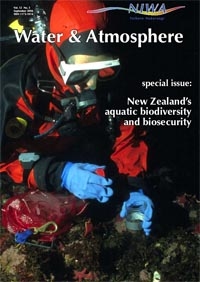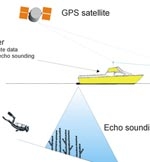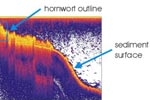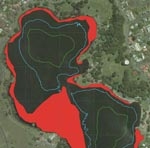PDF of this article (153 KB)

Aleki Taumoeeau Rohan Wells
A new use for a common tool makes lake management easier.
Lake and waterways managers often deal with large areas of nuisance weeds that have the potential to interfere with boating, fishing and biodiversity. Control programmes are best implemented before the weeds become an acute problem. Managers need to define the location and extent of nuisance weed beds prior to implementing control measures, and then follow-up with monitoring to check the outcome and assess the effectiveness of weed control.



Deploying divers to record submerged vegetation data is the most accurate way of assessing the situation. Although this method is reliable and accurate, it can be time-consuming and costly, especially for surveying large areas. Now the same echo sounders used by recreational boaties can help lake managers monitor underwater vegetation at minimal cost.
The advantages of using echo sounders
By rapidly providing information such as the heights of plants, bottom depth and profile, and the distribution of submerged vegetation over large areas, the use of echo-sounders (transmitting at 200 kHz) can greatly reduce the amount of scuba diving or snorkelling necessary. The diving component of the survey is reduced to ground-truthing to identify plant species, make cover estimates and interpret echograms. In some clear-water situations this ground-truthing can be accomplished from the boat with a viewing box and a weighted measuring tape.
The development and integration of global positioning system (GPS) with sounders has made mapping and area calculations possible. Recent advances in sonar microprocessor technology, geographic information systems (GIS), and differential global positioning systems (D-GPS) now also provide an accurate mapping tool. Resulting echograms are a permanent objective record of vegetation that can be used as a baseline for future comparisons and to validate management decisions.
And a few limitations
Surface interference or “noise” caused by bubbles from waves or tall, dense, surface-reaching plants can impair detection by obscuring the return echo. Manipulating the echo sounder’s sensitivity can improve definition of the lake floor or allow profiles to be recorded at greater boat speed. Increasing sensitivity can also make weed beds appear taller and obscure the lake floor, providing double images. For this reason it is necessary to ground-truth the water depth and weed bed height (with a shot line or diver observations) to ensure settings are appropriate for each vegetation type. Shallow water (<2 m) usually requires different settings from deep water (2–10 m deep).
It is difficult or impossible to use an echogram to identify species or determine vegetation cover or density, so conventional methods (such as ground-truthing with a diver) are still required to ensure meaningful interpretation. Within these limitations the echograms remain useful objective records of lake vegetation and can simplify the task of lake or waterway management.
Aleki Taumoepeau and Rohan Wells are based at NIWA in Hamilton.
